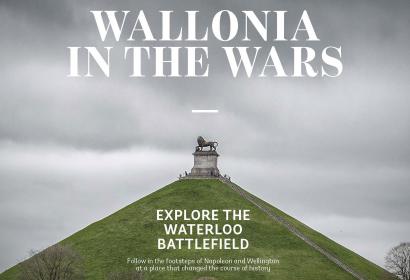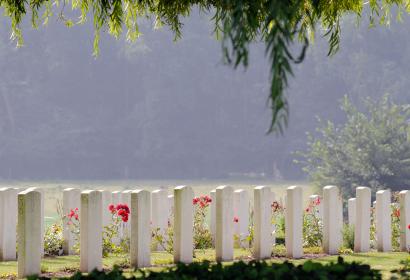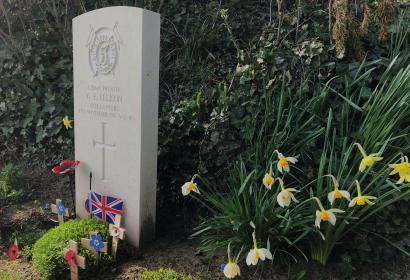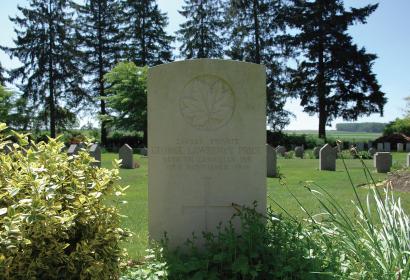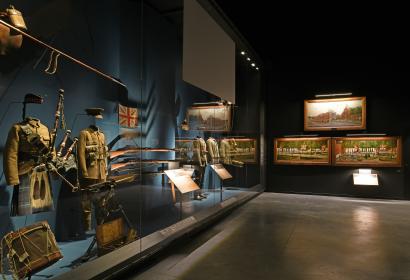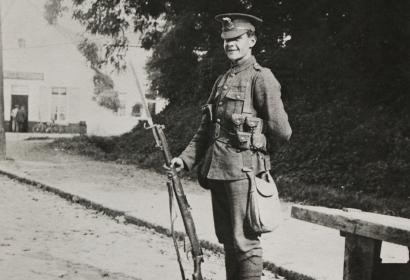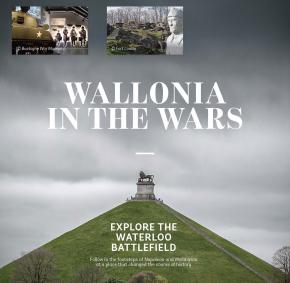The village of Ploegsteert, nine miles south of Ypres in an outpost of Wallonia entirely encircled by Flanders, found itself close to the frontline for nearly all of the war. Apart from a few weeks in 1918 it was held by the British throughout. The ‘Tommies’ – never adept at learning the local lingo – promptly renamed it ‘Plugstreet’.
Over the years it became a maze of billets, canteens and cafés, with tracks and communication trenches leading eastwards to the front. No major battles were fought here, but it has become the stuff of legend for several reasons, and is one of the essential stops on the memorial tourist trail.
CHRISTMAS TRUCE, 1914
In the fields outside the village, one of the most unlikely sporting events in history took place over Christmas 1914, when the two sets of exhausted troops declared an unofficial ceasefire, sang carols, and ventured into No Man’s Land to exchange alcohol, tobacco and food. Commanding officers on both sides, it is said, were not amused. On Christmas Eve and Christmas Day, a series of impromptu football games were staged along the 500-mile frontline, but the most famous of them was at Plugstreet, when the British contingent included a number of kilted soldiers from the Argyle Highlanders, up against the 133rd Saxon Regiment for Germany. It’s generally agreed that the Saxons prevailed, by three goals to two – a precursor of many hard-fought footballing encounters between the two nations that lay ahead, in peacetime.
THE PLUGSTREET 14-18 EXPERIENCE
In November 2013, a remarkable pyramid-shaped museum opened deep in Ploegsteert Wood, with a cinema showing the background to the Great War, a three-dimensional map of the western front and a recreation of both military and civilian life during the see-sawing conflict.
A special presentation spotlights the battle of Messines Ridge in June 1917, when thousands of tonnes of high explosive were detonated beneath the German line. The series of explosions was the most powerful in history, and the shockwaves were felt across the Channel in London, and as far away as Switzerland.
The museum reflects the tunnellers’ subterranean heroics by being sited partially underground.
BRUCE BAIRNSFATHER
A British officer who experienced the truce at first hand was Lieutenant Bruce Bairnsfather of the first Royal Warwickshire Battalion, stationed at the nearby village of St Yves. No football was played there, but the Battalion spent an hour or more fraternising with the enemy in No Man’s Land. ‘There wasn’t an atom of hate on either side that day,’ he wrote, ‘it was just like the interval between the rounds of a friendly boxing match.’ In an evocative memoir, Bairnsfather described how he exchanged tunic buttons with a German officer, and watched aghast as one of his machine-gunners, a hairdresser in peacetime, cut the locks of a compliant German soldier. A few hours later, the guns opened up again, and the Christmas Truce was over – sadly, never to be repeated.
Bairnsfather was a gifted illustrator, who used his free time during the first winter of the war to create the much-loved caricature, ‘Old Bill’, notable for his gruff appearance, prominent walrus moustache and woollen balaclava, whose caustic comments from the frontline became an overnight sensation and a morale-raiser for the troops after they first appeared in the national press. Bairnsfather was wounded during the Second Battle of Ypres, but after recovering from shellshock and hearing damage back home he was attached to the War Office in 1916 as an ‘Officer Cartoonist’, touring most of the flashpoints along the Western Front. Eight collections of his work sold over a million copies.
CHURCHILL AT PLUGSTREET
The wall of the mairie in Ploegstreet is adorned by a plaque commemorating Winston Churchill’s few months in the thick of the action in early 1916. The wartime hero is depicted in World War Two style with the characteristic hunched shoulders, cigar and walking stick. In 1916 he would not have looked like this: he was a vigorous 42-year-old, eager to rehabilitate himself after taking responsibility for the disastrous Gallipoli campaign in Turkey, and resigning from the government. Three days after his resignation speech in the House of Commons, he left for France. Four days later he was in the trenches. Eventually a command role was found for him, and Lieutenant-Colonel Winston S. Churchill joined the 6th Royal Scots Fusiliers, based at Ploegsteert. In occasional quiet moments he painted some watercolours of the Battalion’s HQ - a shell-battered farm - but he spent several hours on the frontline trenches and made a night-time visit to No Man’s Land, coming under fire from German machine-gunners. As the months went by and British casualties mounted, it became clear that Churchill’s battalion would have to amalgamate with others, and he would lose his command. Unwilling to accept this, the ever-restless bulldog returned to London to resume his parliamentary duties.
MILITARY CEMETERIES AND THE MEMORIAL TO THE MISSING
There are more than a dozen cemeteries and memorials in and around Plugstreet – two of them especially significant – and many are named after places in London and the Home Counties. One of the largest is the Strand Military Cemetery, just north of the village, containing more than 1,000 burials. A little further north is Hyde Park Corner (Royal Berkshire) Cemetery, which was extended across the road in 1916 and, along with 876 named stones, contains the Ploegsteert Memorial to the Missing, dedicated to those who lost their lives between Warneton and Estines, but whose bodies were never recovered.
This graceful circular structure, flanked by two large stone lions, opened in 1931. The marble is engraved with the names of the ‘11,447 officers and men of the forces of the British Empire whose names are here recorded but to whom the fortune of war denied the known and honoured burial given to their comrades in death.’ These men are certainly not forgotten: on the first Friday of every month the Last Post is sounded at 7pm.
